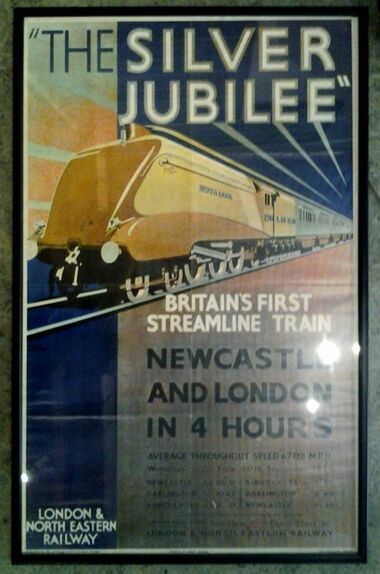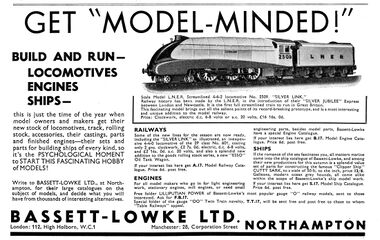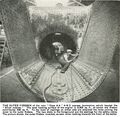Category:The Silver Jubilee (train)
1935: "The Silver Jubilee: Britain's First Streamlined Train" booklet cover [image info]
1935: carriages, internal layout [image info]
1935: Poster for the The Silver Jubilee streamlined express train service, showing 2509 Silver Link [image info]
1936: 2509 Silver Link, advert for Bassett-Lowke [image info]
1939: Hornby gauge 0 "Silver Jubilee" train set [image info]
~1939-: Hornby gauge 0 "Silver Jubilee" Train set [image info]
The Silver Jubilee (1935-1939) was billed by LNER as Britain's first streamlined train.
Hauled by the new 1935 streamlined A4-Class locomotives (typified by the later 4468 Mallard), The Silver Jubilee also boasted luxurious new silver coaches, including paired sets of coaches that shared a common bogie for a quieter and smoother ride.
Naming and livery
The name and livery of The Silver Jubilee commemorated the 1935 Silver Jubilee of King George V, and the first four A4-Class locomotives, as well as being silver-coloured, also had names starting with "Silver-".
Unfortunately for LNER's publicity plans, the King died in 1936, and subsequent A4 locos and their trains abandoned silver and used different colour schemes. For instance, the subsequent LNER "Silver-Jubilee-derived" streamlined train "The Coronation" (1937) used a deep blue as a reference to the coronation of George VI (competing with the similarly-named 1937 blue-and-silver LMS Coronation Scot streamliner).
The outbreak of WW2 in 1939 and the new wartime priorities for the rail network ended all the British high-speed streamlined luxury train services (including The Coronation and Coronation Scot), and by the end of the war, heavy use and reduced track maintenance resulted in more stringent speed limits, and the combination of degraded track and postwar austerity meant that these services never returned.
The four "Silver Streaks"
- 2509 Silver Link (1935-62)
- 2510 Quicksilver (1935-63)
- 2511 Silver King (1935-65)
- 2512 Silver Fox (1935-63)
1935 promotional info:
THE SILVER JUBILEE
has been designed to run at exceptionally high speeds, and at the same time to give the travelling public a special degree of comfort. It is the first train running on a British railway to be "streamlined" throughout. Travelling for long distances at an average speed of over seventy miles an hour, "The Silver Jubilee" will occupy an exceptional share of the running lines and must be well loaded, if it is to pay its way. The retention of the train as a permanent feature of the timetable will depend upon its popularity.
"The Silver Jubilee" is intended for the use of passengers to and from London only. To avoid possible disappointment, a special seat allocation system has been inaugurated and, to ensure the comfort of passengers, seat reservations are limited to 158 (62 First Class, 96 Third Class). Intending passengers are invited to make reservations in advance as early as possible at the undermentioned offices :-
- NEWCASTLE
- Inquiry Office, Central Station Telephone - 23567
- DARLINGTON
- Station Booking Office - 2594
- LONDON
- Inquiry Office, King's Cross Station - Terminus 4200
- 59, Piccadilly, W.l - Regent 3437
- 71, Regent Street, W.l - Regent 6423
- Thos. Cook & Son Ltd.,
- Berkeley Street, W. 1, & Branches - Grosvenor 4000
- Dean & Dawson Ltd., Mansion House
- 63, Fenchurch Street, E.C.3 & Branches - 4432/3
If intending passengers do not find it convenient to obtain their reservation tickets at the above-mentioned offices, seats may be reserved through any of the Company's Passenger Agencies or stations, provided that sufficient notice is given before the date of the journey.
A small supplementary charge per seat (5s. First Class, 3s. Third Class) will be made in view of the exceptionally fast service afforded : this payment includes the fee for seat reservation, and may be made at the time of booking or to the train attendant.
DESCRIPTION OF ENGINE AND TRAIN
The outward appearance of the engine and train vehicles is entirely new. The engine, of the Pacific type, is streamlined and painted grey in several tones: it is named "Silver Link." The tender is built up to the loading gauge and has a corridor through it. The leading dimensions are as follows:-
- Length over buffers, 70' 6 1/8".
- Weight, working order, 165 tons.
- Boiler pressure, 250 lbs./sq. in.
- Diameter of driving wheels, 6' 8".
- Cylinder diameter, 18 1/2".
- Stroke, 26".
- Tractive effort, 35,500 lbs.
The train is composed of seven articulated vehicles consisting of a Twin Brake First, Triplet Restaurant Car Set and Twin Brake Third. The sides are covered in Silver Rexine outside, whilst the exterior mouldings, window frames and lettering are in stainless steel. The spaces between the articulated carriages are covered with special Indiarubber sheeting to reduce the wind resistance; wherever possible outside projections have been suppressed.
A system of pressure ventilation is employed by means of which filtered air, heated in winter to a comfortable temperature, is supplied to the Restaurant Cars and compartments. The windows consist of double glass with an intervening air space, which reduces noise to a minimum.
A novel arrangement of lighting using tubular lights has been installed and the decoration of the interior of the train strikes a new note in railway carriage decoration by the employment of flat surfaces and the suppression of all mouldings. The First Class Restaurant is veneered in quartered Australian Maple and the Third Class in Burmah Teak. The ceilings are finished to harmonise with the colour scheme used. Separate armchairs are provided in the First Class Restaurant Car. The compartments are tastefully decorated in Rexine to match the upholstery materials. An electric speedometer for the convenience of passengers interested in the speed of the train has been fitted in the First Class Restaurant Car.
The Kitchen Car is provided with improved electric cooking and refrigerating apparatus in accordance with the most recent practice. No attempt has been made to produce a lightweight train at the expense of the passengers' comfort: the weight, excluding the engine, is 220 tons, and the length 392' 0". Seats are provided for 78 First and 120 Third Class passengers.
The weight of the complete train, including the engine, is 385 tons, and the overall length over buffers is 462' 2 3/8".
SEAT RESERVATIONS
Every seat in the train is numbered, and reservations can be made at the offices mentioned on page 4. The supplementary charges per seat are 5s. First Class and 3s. Third Class.
BANK HOLIDAYS, ETC.
"The Silver Jubilee" train will run each weekday, Monday to Friday inclusive, except on the following dates:-
- December 20th to 27th inclusive, 1935
- April 9th to 13th inclusive, 1936
A TRAIN ATTENDANT
travels with the train and will be happy to render to the passengers any service which will be helpful in ensuring the fullest possible comfort on the journey. He will undertake the posting of letters or dispatch of telegrams.
NOTEPAPER AND ENVELOPES
are provided for the use of passengers and can be obtained free of charge from the Train Attendant.
MEALS AND REFRESHMENTS
will be served in the Restaurant Cars or, if desired, at the tables in the ordinary carriages.
RESTAURANT TARIFF
- LUNCHEON
- Table d'Hôte 1st Class 3'6
- Table d'Hôte 3rd Class 3'6
- Two Course Meal 2'6
- DINNER
- Table d Hote 1st Class 5'-
- Table d'Hôte 3rd Class 4'6
- Three Course Meal 3'6
- AFTERNOON TEA
- Tea or Coffee, Toast or Tea Cake, Bread and Butter Cake or Pastry 1'-
- Tea or Coffee Bread and Butter or Cake or Toast 9d.
- Pot of Tea 6d.
For children travelling with half-fare tickets, half-price only is charged for luncheon or dinner, with a minimum charge of 1'9.
LNER streamliner trains
- Silver Jubilee (1935-39) - Kings Cross to Newcastle (silver)
- The Coronation (1937-39) - Kings Cross to Edinburgh (blue)
- The West Riding Limited - London to Yorkshire (similar to The Coronation, but without observation car "tail")
There was also the East Anglian, introduced in 1937, that ran between Liverpool Street Station (London) and Norwich. The East Anglian wasn't a premium-priced service, and didn't have special coaches, and although it looked as if it was hauled by A4s, its locos were actually a couple of the not-very-successful B17 locomotives, decked out (some would unkindly say "faked-out") in a green streamlined cladding that was closely based on the A4s' streamlined shell.
See also:
Subcategories
This category has only the following subcategory.
Pages in category ‘The Silver Jubilee (train)’
The following 5 pages are in this category, out of 5 total.
Media in category ‘The Silver Jubilee (train)’
The following 14 files are in this category, out of 14 total.
- 25 miles at 107 mph, Silver Jubilee train (RWW 1936).jpg 2,000 × 1,145; 609 KB
- Beginning the Run, Silver Jubilee train (RWW 1936).jpg 2,000 × 1,336; 753 KB
- Hornby Silver Jubilee Train Set (1939 HBot).jpg 3,270 × 1,232; 633 KB
- Hornby Silver Jubilee train set No.0 (1939-).jpg 2,397 × 819; 404 KB
- Outer Firebox, Silver Jubilee train (RWW 1936).jpg 2,000 × 1,949; 1.05 MB
- Over 70 mph, Silver Jubilee train (RWW 1936).jpg 1,571 × 2,000; 989 KB
- Silver Jubilee Poster.jpg 426 × 643; 76 KB
- Silver King locomotive LNER 2511 (Bassett-Lowke 4606).jpg 3,000 × 748; 363 KB
- Silver Link head-on, Silver Jubilee train (RWW 1936).jpg 1,369 × 2,000; 611 KB
- Silver Link LNER 2509, Bassett-Lowke, Get Model-Minded (MM 1936-10).jpg 2,200 × 1,392; 658 KB
- Silver Link, Silver Jubilee train (RWW 1936).jpg 1,564 × 2,000; 769 KB
- Special Coaches, Silver Jubilee train (RWW 1936).jpg 2,000 × 1,518; 762 KB
- The Silver Jubilee booklet, cover (LNER 1935).jpg 3,000 × 2,003; 4.45 MB
- The Silver Jubilee, booklet, carriage layout diagram (LNER 1935).jpg 3,000 × 2,029; 2.67 MB



















